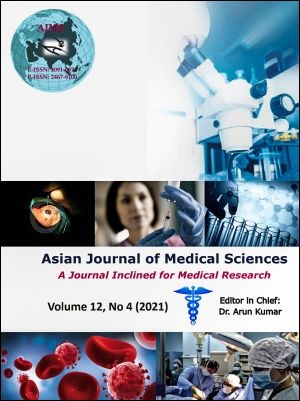A Randomised comparison and evaluation of I-gel, Supreme laryngeal mask airway and Ambu Auragain in Laparoscopic surgeries under general anaesthesia with controlled ventilation
Keywords:
Supraglottic airway devices, Laparoscopic surgeries, Airway leak pressure, Ease of insertionAbstract
Background: Supraglottic airway devices (SAD) are becoming increasingly popular for use in patients undergoing laparoscopic surgeries. In this prospective randomised study, we compared three supraglottic airway devices namely, I-gel, Supreme LMA and Ambu Auragain.
Aims and Objectives: The study was undertaken to compare three supraglottic airway devices I-gel, Supreme LMA and Ambu Auragain in laparoscopic surgeries under general anaesthesia with controlled ventilation.
Materials and Methods: This was a randomized comparative study in which 90 patients undergoing laparoscopic surgeries under general anesthesia were included. In group A Ambu AuraGain was used whereas in group I and Group S I-gel and Supreme LMA was used respectively. Primary outcome measures which were compared amongst the studied groups included time taken for insertion, ease of insertion, attempts required for insertion, ease of insertion of Ryles tube, fiberoptic bronchoscopic grading and Oropharyngeal leak pressure.
Results: There was highly significant difference in the time taken for insertion of SAD in Group-A when compared to Group- I (p<0.0001) and Group-S (p<0.0001). Group-A had significantly increased grades of ease of insertion of SAD when compared to Group-I (p=0.04) and Group-S (p=0.004). 16.66% of patients in Group-A required 3 attempts for successful insertion of the SAD, while no patients in Group- I or Group A required more than two attempts for insertion(p<0.05).
Conclusion: Ambu AuraGain provides better oropharyngeal seal and has higher leak pressures as compared to I-gel and Supreme LMA with similar hemodynamic stability and post-operative outcome makingit a preferable SAD over I-gel and Supreme LMA.
Downloads
Downloads
Published
How to Cite
Issue
Section
License
Authors who publish with this journal agree to the following terms:
- The journal holds copyright and publishes the work under a Creative Commons CC-BY-NC license that permits use, distribution and reprduction in any medium, provided the original work is properly cited and is not used for commercial purposes. The journal should be recognised as the original publisher of this work.
- Authors are able to enter into separate, additional contractual arrangements for the non-exclusive distribution of the journal's published version of the work (e.g., post it to an institutional repository or publish it in a book), with an acknowledgement of its initial publication in this journal.
- Authors are permitted and encouraged to post their work online (e.g., in institutional repositories or on their website) prior to and during the submission process, as it can lead to productive exchanges, as well as earlier and greater citation of published work (See The Effect of Open Access).




